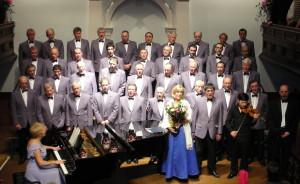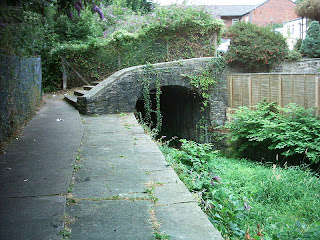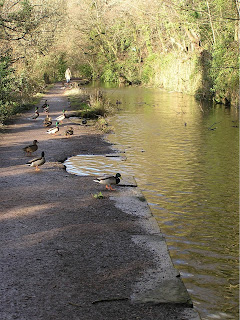Blogs

Cardiff City legend and not a player in the team now fit to clean his boots.
RIP
Your name is carved in Folk law.
Important Musical Event In Portland On September 4th - Cor Godre'r Aran at NAFOW
By Ceri Shaw, 2010-08-11

Details:- The Concert is on Saturday 4th September between 7 and 10 pm at the Doubletree Hotel, Lloyd Center, Portland. Tickets have been discounted to $20 and are available in the hotel foyer before the performance. Following the concert the choir will be at the pub night in the bar at the Doubletree.
For more information contact Janet Figini @ jpfigini@cascadeaccess.com
From the WNGGA website:- "The forty-six member choir was formed in 1949 in Llanuwchllyn, a village nestled between the shores of Llyn Tegid (Bala Lake) and the Aran mountain, which stands majestically above. It is an area steeped in history, literature and music. Llanuwchllyn retains a firm Welsh identity in a modern and vibrant Wales, and its inhabitants are almost all Welsh speaking. The choir has travelled extensively, to Canada, the U.S., Argentina, Brazil, Hong Kong, Singapore and Portugal. In November 2003 it visited New Zealand for the 3rd time and Australia for the 7th. In 2005 and 2006 it participated in Saint Patricks Day celebrations in Macroom, County Cork, and returned to Patagonia in the autumn of 2007. Cr Godrer Aran has achieved repeated success in Male Choir competitions; between 1989 and 1993, it won four victories at the National Eisteddfod of Wales and, in 2001, returned to the National Eisteddfod and triumphed once more. Cr Godrer Aran won first prize at the International Eisteddfod at Llangollen in 1996, 2000, 2005 and 2008, and won the BBC Radio Cymru Male Choir of the Year competition in 2005. A new CD, Cofio, was released in the summer of 2009. The choir has shared platforms with the Bands of the Royal Marines, Grenadier Guards, Royal Scots Guards, Pipes and Drums, and has welcomed renowned international guest artists to perform with it. Singers are from farming and various rural occupations and are held together by a strong bond of friendship and a love of singing. In addition, the choir has its own talented soloists whose contributions
are invaluable."
 |
| GFDL Former tunnel of the Glamorganshire Canal at Pontypridd, behind the Bunch of Grapes pub. Photo taken by User:Varitek July 2005) |

Dr. Karl Jenkins is one of Britain's greatest and most versatile living composers, the author of an ocean of amazing and exalting music unlimited by genre, style or instrument. He holds a doctorate of musicology from the University of Wales and the Royal Academy of Music London. His many awards include several fellowships at various universities and an OBE (Order of the British Empire) for "services to music." He has composed for jazz bands, orchestra and voice, for advertising, film, and live performance. Dr. Jenkins is a native of the village of Penclawdd in the Gower peninsula, where his father was a school teacher and the choirmaster and organist of the Methodist church the family attended.
Two of his most recent works are Stabat Mater (2008), an adaptation of a 13th century Roman Catholic prayer and Stella Notalis (2009), adaptations and compositions of Christmas carols from around the world.
Americymru: You'll be appearing as guest conductor at Carnegie Hall on March 6th . What are the circumstances and what will you be conducting?
Karl: As part of Welsh Week I've been asked to conduct some of my music as the first half of the concert. I have a strong relationship with Jonathan Griffith of DCINY who has arranged the event and who has been fantastic in that he has conducted and supported much of my work in the USA. On Martin Luther King Day 2010 he performed my The Armed Man: A Mass for Peace and my Requiem. On this occasion I shall be conducting Palladio [famous for its use on a TV ad for diamonds], two choral extracts, Benedictus & Ave verum [from the Armed Man & Stabat Mater respectively] and the USA premier of my Concerto for Euphonium & Orchestra played by David Childs for whom it was written.
Karl Jenkins Conducts "Palladio"
Americymru: You're a musician, your wife is a musician, your son is a musician, your daughter-in-law is a musician, your father was a musician, has music always been part of your family's life?
Karl: Well obviously that is the case. My father started the ball rolling really since he was hugely influential with regard to my musical education. He taught me piano from an early age and music was always in the house, both live & recorded. My wife Carol Barrat is a celebrated music educationalist while our son, a percussionist and film composer has just scored a Bollywood movie! His wife Rosie, whom he met in the National Youth Orchestra of Great Britain is currently playing oboe with the London Symphony Orchetra.
Americymru: You've said in other interviews and your biography that your father was the organist and choirmaster at your village's Methodist chapel, was he the greatest musical influence in your life? Do you think you've been the same influence in your son's life?
Karl: What we've done as parents is introduce Jody to music and by default, the musicians life so he's quite worldly for a young man [he's 28]. We did not force him in any way and having played piano & flute as a child, he asked to play percussion when he was ten. This was his instrument and became principal in the aforementioned NYOGB, won a scholarship to the Royal Academy of Music [where I had studied 30 years before] and graduated with first class honours. So, he's been his own man really but I suppose it helps in that we work in different areas. What we do all share as a family is a love of all good music, regardless of categorisation, and in any genre.
Americymru: How would you describe Welsh congregational singing to someone who's never seen it? Would you say that growing up with that musical experience effected or enriched you as a composer?
Karl: It's obviously hard to describe music in words but what makes it unique is the rawness of the vocal sound. On the printed page it looks like any other four part hymn but the sound, to me anyway, is hugely atmospheric especially when sung in Welsh. The sound influenced my Adiemus project which had a degree of global success. This was a mix of the 'classical' but with voices that were not from the European classical tradition but more "tribal". The text was my own invented language.
Americymru: You've performed and composed a very wide variety of instruments and styles of music and incorporate a great variety in your work, from the 13th century Roman Catholic Stabat Mater to Japanese haiku and African folk - what inspires or directs fitting these styles together in a piece? Where do you start writing music or creating music?
Karl: My musical journey, following academic classical training at Cardiff University & the RAM, has taken in a wide variety of genres and I've arrived at what I do now by way of being a musical tourist. Essentially I am a composer who always looks outside the European tradition for influences, texts & instrumentation, particularly percussion. With regard starting a piece, if I'm setting words then I immediately have a peg on which to hang the piece. If it's instrumental or Adiemus then I'm on my own! The principle is searching around for ideas [usually using a piano] and developing what takes my fancy. A huge amount of intuition is involved, but intuition based on an armoury of acquired musical craft; harmony, counterpoint, orchestration, form et.
Americymru: "Stabat" Mater (2008) is your adaptation of a 13th century Catholic liturgical hymn, in which you included an amazing variety of instruments and material from sources as wide as 13th century Persian poetry and the Epic of Gilgamesh, how did you come to create this, what was your process in expressing this?
Karl: Well the established text is there already. Then much of what I have expressed above came in to play, looking outside Europe to the Middle East/Holy Land for relevant [i.e. concerning grief] ancient text, employing languages that were lingua franca at the time and including indigenous instruments in the orchestration. The eminent Welsh poet [and academic] Grahame Davies [who wrote the words for my recently composed anthem for the National Assembly of Wales] did quite a bit of research for me with regard to the literature.
Americymru: You've said in interviews before that you "don't see any point in being a composer if you don't communicate with people," what does that mean to you? Do you feel that response in the audience is important, that response is the "product" or goal of a piece of art or music? What response do you want to create in your audiences?
Karl: I believe music should emotionally connect with an audience; make them cry, laugh, administer 'goose bumps! I've heard far too much music with 'one man and his dog' in the audience, the piece never heard again and the event receiving "critical acclaim".
Americymru: Wales seems to produce a lot of musical artists who would be (or are) described as "crossover", yourself included - do you think Wales has a musical character or tradition that inspires or tends toward experimentation or something like hybridization, a lack of adherence to artificial limitations of genre?
Karl: I don't like to use the term cross-over. I'm not sure what it means and I've explained what I do above. I don't think the Welsh like music particularly. What they do like are singers which is not necessarily the same thing. I like to think that what I do is at least individual and at least it's new. Most albums and repertoire [not just by Welsh artists] are a series of singers singing the same songs, songs that everyone knows. Many such artists are described as opera singers when they have never sang in an opera in their lives. At least good modern 'pop' has more integrity since it is newly composed.
Americymru: Did you have particular creative goals as an artist and if you did, have you achieved them? What would you like to look back on at the end of your life and see that you did or created?
Karl: Following my journey, I have come relatively late in life to what I do now, but the corollary is that I would not have arrived at this point without this musical tourism and the influence and skills that have come with it. There is still much to do. I'm setting the Gloria text for a Royal Albert Hall premier in July and there is much more to do.
Americymru: Is there any particular instrument you especially like to compose for? If so, what instrument and why?
Karl: Sounds pompous [which I'm not] but my instrument is the orchestra [& choir] and the rich palette of colours it provides.
Americymru: Is there any one work or piece that you created that you're particularly proud of or happy to have done? If so, what is it and why?
Karl: The worrying thing is that some of my most popular pieces were kind of written quickly and which I didn't set great store by. However, I suppose the Armed Man because of it's impact but I think there is better music in the Requiem.
Americymru: What music do you listen to for pleasure?
Karl: I listen far less than I did, most certainly because I'm always writing and I need a break! Favourites would be Mahler, Strauss, Wagner, Bach, Stravinsky, Miles Davis, John Coltrane, Weather Report, Steely Dan........

My mother was bedridden and no-one remained of the familys older generation to speak to her in Welsh so I decided to learn the language with her in 1994. When my mother died I promised myself that I would continue to learn to speak and write in Welsh.
In 2001 Susan won the Learners Chair in the National Eisteddfod with the poem Yfory , which is included in this book along with several poignant and honest poems which discuss her childhood and life and topical issues such as open-cast mining. The poems look at the scars left behind on the landscape by the heavy industries of the area,
Three coal mines employed 3,000 miners in the Maesteg area and some of the poems look at the beauty which has returned to these valleys.
Her Welsh tutor, Morgan D Jones, has clearly made an impression on Susan as she has written a poem especially for him and he has written the foreword for this volume. Susan May was a lecturer in midwifery prior to her retirement. In order that Welsh learners can enjoy the poems she has included a vocabulary for each one. Cerddir Galon is sure to enrich the experience of learning the Welsh language, and will appeal to learners of different standards and Welsh speakers alike. The price of Cerddir Galon , which is part of the Golau Gwyrdd (Green Light) series by Y Lolfa, is 4.95.
David Western's Portland Eisteddfod Lovespoon: Dave is done! : "Well, I think I am just about done. I had a good day yesterday and managed to get most of my part seen to. There might be a couple of..." more here

 |
| Image by w:User:Dave souza License CC Attribution-ShareAlike 2.5 |
 |
| Image by Arthur Webster |
Campbells struggled on with various motor vessels including MV Balmoral, before it too finally succumbed to the economic pressure and the Channel finally fell silent in 1980. It seemed that the Bristol Channel would never hear the beat of paddles on water again. However, in 1974, the Scottish arm of the Paddle Steamer Preservation Society had bought paddle steamer Waverley for the sum of just 1. Looking to increase her financial horizons beyond the Clyde where she was based, they brought the last sea-going paddle steamer in the world to the Bristol Channel for a few weeks in early 1979. She was received with great delight.
 AmeriCymru: Can you explain to our readers what the name 'Swci Boscawen' means?
AmeriCymru: Can you explain to our readers what the name 'Swci Boscawen' means?Mared: Swci means tame lamb in welsh.Something rather cutesy.Boscawen is a wild flower and also a place in Cornwall.I thought they sounded nice together and the name just stuck.
AmeriCymru: How long have you been involved in the Welsh music scene?
Mared: 14 years! I started in bands when I was 12 and kept it going amazingly! I haven't a clue how...
AmeriCymru: You have performed in he US before. Care to tell us a little about that? Do you have any plans for future visits?
Mared: New York has always been a place I go frequently to play gigs,do some filming or just visit friends.It's been great to me and I always try and go at least twice a year although I havent been for a lot longer now.The pangs are indeed coming back.
AmeriCymru: Can you tell us a little more about your new label Tarw du?
Mared: It is absolutely fabulous.Gruff Meredith who runs it has worked so hard to make it professional and slick.We're lacking good solid welsh music labels today and I really hope Tarw Du does really well.It deserves to.No longer will you have to walk into a little welsh shop and talk family gossip before you can purchase a Swci cd!
AmeriCymru: I know its an overworked question but who would you describe as your main musical influences? Who are you listening to currently?
Mared: Im a hardcore Blondie fan.And I am obsessed with pop music at the moment.But all in all,anything floats my boat.
AmeriCymru: What are some of your favorite places and must see/experience things in Wales?
Mared: West Wales is my part and I don't think you can beat it for looks.There's something maddening about Wales where you spend lots of time wanting to get the hell away from it but the moment you do the "hiraeth" kicks in and all you want is to be there! Oh and the people,I like how you can't get away with anything because you will be put in you place faster than lightning.
AmeriCymru: 'Adar y Nefoedd' is an extremely moving and powerful ballad. Can you tell us what inspired it?
Mared: It's a song about a fair few people that I have known or known of that are no longer with us.I got frustrated with people being forgotten so I wanted to try and write something that at least was a nice tribute.It came out all right I think!
AmeriCymru: Tell us about your new Super Single and how it came about
Mared: Music has been stale lately and I wanted to brighten 2010 up with some pure,unapologising pop.It's my secret bikini hit that I want people in Ibiza to go mental to!
AmeriCymru: What's next for 'Swci Boscawen'?
Mared: Recovery unfortunately.6 days ago I was diagnosed with cancer so I have to get through this particularly difficult time with some sort of dignity when all I want to do is gig and have fun!
AmeriCymru: Where can people go to download or purchase your songs?
Mared: Amazon,I tunes,etc i think! give google a little click...
AmeriCymru: Any further message for the members and readers of AmeriCymru?
Mared: Just keep the welshness up.The world is filled with us and it's pretty awesome how we get around isnt it?
Hope everyone enjoys the Portland Eisteddfod and thanks for the interview!
Diolch Ceri,
Mared.

The recent outbreak of of deliberate and calculated drollery in status updates on AmeriCymru is much to be welcomed. We only wish more people would get in on the act. Since the status updates feature was added a while back, a few members have made use of it but many more have yet to discover its point and purpose.
To update your status on AmeriCymru simply log in to the site and go to your home page. Right at the top you'll find the status update feature. Simply type your message in the 'What's New' box and hit the 'Update' button to have your comment appear on the AmeriCymru front page in the activity feed. It is even possible to conduct a ( very public ) dialog this way by commenting on, or responding to previous updates by other members and, If dialog isn't your style, you could always conduct a public monologue by commenting on your own.
How Welsh is That?
...I hear you ask. Well I daresay we have all bought a local newspaper somewhere in Wales to find the following headline on the front page:- "Mrs Jones Cat Stuck Up Tree...Rescued By Fire Brigade!". Indeed this sort of thing is the mainstay of Welsh local news. So it could be said that disseminating and enjoying inanities and inconsequential snippets of information is very much a part of the national character. OK , I'm not going to claim that it is your patriotic duty to fill the activity feed with fatuous remarks but on the other hand we really do want to hear about it if you've recently taken the dog for a walk, cut your toe-nails or discovered an interesting snail in your yard.
But Seriously Folks...
Staus updates do serve another, and slightly more useful purpose. You will notice that there are two check boxes adjacent to the 'What's New' field . One for Twitter and one for Facebook. Lets suppose you have accounts on all three services ( AmeriCymru, Facebook, Twitter ) and you have a Welsh related blogpost that you want to promote. You can compose a status update message on your home page incorporating the url of your post and simply check the Twitter and FB boxes before hitting 'Update'. That way the link will appear on all three services simultaneously. This is an easy way to spread the word when you have something interesting to say and you want to be heard.
So......whether you just want to tell us about your latest trip to the library or promote your latest literary creation, we cordially invite you to try out the status updates feature. Either way, we welcome your input 




